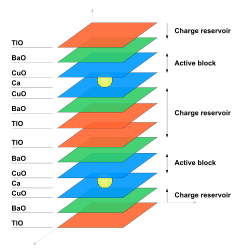Thallium barium calcium copper oxide
Thallium barium calcium copper oxide, or TBCCO (pronounced "tibco"), is a family of high-temperature superconductors having the generalized chemical formula TlmBa2Can−1CunO2n+m+2.

Tl2Ba2Ca2Cu3O10 (TBCCO-2223) was discovered in Prof. Allen M. Hermann's laboratory in the physics department of the University of Arkansas in October 1987 by the post-doctoral researcher Zhengzhi Sheng and Prof. Hermann.[1] The bulk superconductivity in this material was confirmed by observations of magnetic flux expulsion and flux trapping signals (under zero field cooled and field cooled conditions) with a SQUID magnetometer in the superconductor laboratory of Timir Datta in the University of South Carolina.[2] Allen Hermann announced his discovery and the critical temperature of 127 K, in Houston, Texas at the World Congress on Superconductivity organized by Paul Chu in February 1988.
See also
References
- Sheng, Z. Z.; Hermann A. M. (1988). "Bulk superconductivity at 120 K in the Tl–Ca/Ba–Cu–O system". Nature. 332 (6160): 138–139. Bibcode:1988Natur.332..138S. doi:10.1038/332138a0.
- Sheng, Z. Z.; Hermann, A.M.; El Ali, A.; Almasan, C.; Estrada, J.; Datta, T.; Matson, R.J. (1988). "Superconductivity at 90 K in the Tl-Ba-Cu-O system". Physical Review Letters. 60 (10): 937–940. Bibcode:1988PhRvL..60..937S. doi:10.1103/physrevlett.60.937. PMID 10037895.
- Copper Oxide Superconductors:, by Charles P. Poole, Timir Datta, Horacio A. Farach, John Wiley & Sons, 1988, ISBN 0-471-62342-3
- Superconductivity: Its historical Roots and Development from Mercury to the Ceramic Oxides, by Per Fridtjof Dahl, AIP, New York, 1st ed. 1992, ISBN 0-88318-848-1